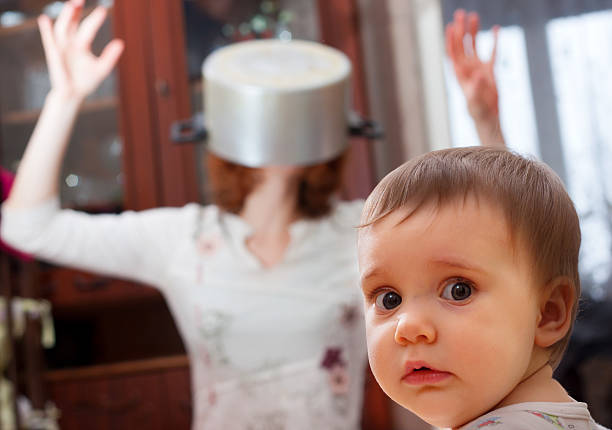Introduction:
Parenthood is a beautiful journey filled with moments of joy, but it also comes with its fair share of challenges. For mothers of toddlers, managing fears and nighttime anxiety can be particularly daunting. As a parenting specialist with a focus on child development and the well-being of both children and parents, I understand the importance of addressing these concerns and providing effective strategies to help mothers navigate this delicate stage of their child's development. During time of toddlers go through significant growth and developmental milestones. This period is marked by an expanding sense of awareness, cognitive development, and the emergence of newfound fears and anxieties. As a result, bedtime can become a challenging time for both toddlers and their mothers, with fears and anxieties intensifying during the nighttime hours.
In this comprehensive guide, we will explore various aspects of managing fears and nighttime anxiety in babies. We will delve into the definitions of fears and nighttime anxiety, understanding the unique triggers that affect toddlers during this developmental stage. By shedding light on these concepts, we aim to empower mothers to identify and address their child's concerns effectively, providing them with the tools to create a calm and nurturing environment. Moreover, we will discuss the common problems faced by mothers when it comes to their toddlers' sleep, such as sleep regression and night wakings. These issues can further exacerbate fears and anxiety, making it essential to explore the underlying causes and offer practical solutions to help mothers navigate these challenges.
Through this guide, we will also provide effective strategies that mothers can implement to manage fears and nighttime anxiety successfully. We will emphasize the importance of establishing a calm bedtime routine, creating a safe and comfortable sleep environment, and promoting relaxation techniques that soothe and reassure toddlers. By adopting these strategies, mothers can help their children develop healthy sleep patterns and alleviate nighttime anxiety.
It is crucial to remember that each child is unique, and what works for one may not work for another. However, with patience, understanding, and the implementation of tailored approaches, mothers can support their toddlers through this stage of development. By addressing fears and nighttime anxiety, mothers can create a peaceful and restful sleep experience for their little ones, fostering their overall well-being and promoting a happy, healthy childhood. Join us as we explore the intricacies of managing fears and nighttime anxiety in toddlers, providing insights, practical tips, and comforting strategies that will empower mothers to navigate this challenging phase with confidence and care.
Understanding Fears and Nighttime Anxiety in Toddlers

By understanding these developmental factors and common triggers, mothers can better identify the root causes of their child's fears and nighttime anxiety. This understanding forms the foundation for implementing effective strategies to help their toddlers manage and fight these challenges. Understanding these fears and nighttime anxiety is crucial for mothers to provide the necessary support and help their toddlers overcome these challenges.
1.1: Defining Fears and Nighttime Anxiety
Fears in Toddlers: Fears are a natural part of a child's development, and toddlers are no exception. At this age, their imaginations are expanding, and they are more aware of their surroundings. Common fears in toddlers include loud noises, animals, separation from caregivers, and the dark. These fears can trigger feelings of anxiety and unease in your child, especially during nighttime.
Nighttime Anxiety: Nighttime anxiety refers to the heightened sense of fear or unease experienced by toddlers during bedtime or throughout the night. It can manifest in various ways, such as difficulty falling asleep, frequent night wakings, or reluctance to sleep alone. Nighttime anxiety is often related to specific fears or triggers, such as separation anxiety or fear of the dark.
1.2: Developmental Factors and Common Triggers
Toddler Development and Fears: As toddlers grow and develop, they go through different stages that contribute to the emergence of fears. Separation anxiety is common in toddlers around 1 to 2 years of age, as they become more aware of their attachment to their primary caregivers. They may display distress when separated from their mothers or exhibit clinginess. Stranger anxiety is another fear that often arises during this stage. Toddlers may become anxious or wary of unfamiliar people, leading to discomfort or fear when encountering strangers.
Fear of the Dark: Fear of the dark is a common fear among toddlers, as their imaginations create imaginary monsters or creatures lurking in the shadows. The absence of light during nighttime can amplify their fear, making it difficult for them to feel comfortable and secure.
Changes in Routine and New Environments: Toddlers thrive on routine and familiarity. Any sudden changes in their daily routines or exposure to new environments can trigger fears and anxiety. For example, moving to a new house, starting daycare, or having a significant change in their daily schedule can cause unease and distress for toddlers.
Strategies to Ease Nighttime Anxiety

By implementing these strategies, you can create a nurturing sleep environment and empower your toddler to develop healthy sleep habits, leading to improved nighttime anxiety management and better overall sleep quality for both you and your child.
2.1 Establishing a Calming Bedtime Routine:
A consistent and soothing bedtime routine is key to helping toddlers overcome nighttime anxiety. By following a predictable sequence of activities, you create a sense of security and signal to your little one that it's time to wind down and prepare for sleep. Some effective elements to include in the bedtime routine are:
- Bath time: A warm bath can be soothing and help your toddler relax before bed. Use gentle, calming bath products and make it an enjoyable experience.
- Reading a story: Choose age-appropriate books with soothing themes and read aloud to your toddler. This not only promotes language development but also creates a quiet and calming atmosphere.
- Gentle cuddling: Spend some quality time snuggling with your child, providing reassurance and a sense of closeness. Gentle physical contact can help them feel secure and loved.
2.2 Creating a Comfortable Sleep Environment:
The sleep environment plays a crucial role in reducing nighttime anxiety. Making the sleeping area comfortable and conducive to restful sleep can significantly impact your toddler's overall sleep experience. Consider the following factors:
- Nightlights: Using a dim nightlight can help alleviate the fear of the dark. The soft glow provides a sense of security and makes the environment less intimidating for your child.
- Transitional objects: Introduce a special blanket, stuffed animal, or favorite toy that your toddler can associate with comfort and safety. These familiar objects can provide a sense of security and help ease anxiety.
- Temperature and noise control: Ensure that the room is at a comfortable temperature, neither too hot nor too cold. Additionally, minimize disruptive noises that may disturb your toddler's sleep by using white noise machines or soft background music.
2.3 Encouraging Independent Sleep:
Encouraging your toddler to develop self-soothing skills is an essential step towards managing nighttime anxiety. Teaching them to fall asleep independently fosters a sense of independence and reduces reliance on external comfort. Consider the following strategies:
- Gradual transition: Introduce the concept of independent sleep gradually. Start by staying in the room until your child is drowsy but still awake. Slowly decrease your presence over time until they can fall asleep on their own.
- Comfort objects: Encourage your toddler to use their transitional object, such as a favorite stuffed animal or blanket, to provide comfort and a sense of security while falling asleep.
- Consistency: Be consistent in your approach to independent sleep. Maintain the same routine and bedtime expectations every night, as this consistency helps your child feel secure and understand what is expected of them.
Managing Separation Anxiety

Separation anxiety can be a challenging aspect of nighttime anxiety for toddlers. It is important for mothers to approach this issue with sensitivity and understanding. By implementing strategies to gradually ease separation fears, mothers can help their toddlers develop a sense of security and independence. Let's explore the sub-sections in detail. By addressing separation anxiety head-on and implementing these strategies, mothers can support their toddlers in navigating through this challenging phase. With time, patience, and reassurance, both mothers and toddlers can overcome separation fears, leading to more peaceful nights and a sense of security for the whole family.
3.1 Preparing for Separation:
Preparing your toddler for separation is an essential step in managing separation anxiety. By gradually introducing short periods of separation during the day, you can help your child become more comfortable with being apart.
During these practice sessions, arrange playdates with trusted friends or family members. Start with brief separations and gradually increase the duration as your child becomes more at ease. This process allows your toddler to develop trust in others and understand that separation is temporary.
3.2 Positive Goodbyes:
The way you say goodbye to your toddler can greatly influence their perception of separation. It is crucial to make goodbyes quick and positive, providing reassurance that you will return. This helps build trust and confidence in your child.
Offer a loving and cheerful farewell, maintaining a calm and confident demeanor. Avoid prolonging goodbyes, as lingering departures may intensify separation anxiety. Instead, assure your toddler that you will be back soon and engage them in a fun activity or provide a transitional object to distract them from any distress.
3.3 Transition Objects:
Transition objects play a significant role in providing comfort and security to toddlers when separated from their mothers. These objects serve as a tangible connection, offering a sense of familiarity and reassurance. Introduce a transitional object that holds personal significance to your child, such as a family photo, a small blanket, or a stuffed animal. Encourage your toddler to keep it close during times of separation. This object can provide a source of comfort and serve as a symbol of your presence even when physically apart.
Remember, each child's separation anxiety may vary, so be patient and understanding throughout this process. With consistent practice, positive reinforcement, and the use of transitional objects, you can help your toddler develop confidence and cope with separation more effectively.
Addressing Specific Fears

4.1 Fear of the Dark:
The fear of the dark is a common fear among toddlers that can contribute to nighttime anxiety. As they grow and develop their imagination, the unknown nature of darkness can evoke feelings of unease. However, there are effective strategies to help your child overcome this fear and feel more comfortable in the dark.
-
Gradual exposure: One approach to address the fear of the dark is through gradual exposure. Start by introducing dim lighting or a nightlight in your child's room. This soft illumination can provide a sense of security and gradually acclimate your toddler to the darkness. Over time, you can gradually reduce the brightness of the nightlight to help your child become more accustomed to sleeping in a darker environment.
-
Comforting reassurance: Verbal reassurance is crucial in helping your toddler feel safe and secure in the dark. Explain that darkness is a natural part of nighttime and emphasize that you are there to protect them. Offer comforting words of assurance and remind them that their room is a safe space where they can rest and have peaceful dreams.
4.2 Nightmares:
Nightmares can be distressing for both toddlers and parents. These vivid and often frightening dreams can disrupt sleep and contribute to nighttime anxiety. However, there are strategies you can employ to help your child cope with nightmares and create a more soothing sleep experience.
-
Creating a safe space: After a nightmare, it is essential to establish a comforting environment for your child. Offer cuddles, gentle soothing words, and physical reassurance to help them feel safe and secure. Create a sense of calmness by dimming the lights, providing a cozy blanket, or engaging in a calming bedtime routine. This will help your toddler transition from the unsettling dream to a more peaceful state.
-
Calming activities: Incorporating calming activities before bedtime can reduce the likelihood of nightmares. Engage in relaxing activities such as reading a soothing story, listening to gentle music, or practicing deep breathing exercises together. These activities can promote relaxation and create a positive and serene atmosphere that encourages pleasant dreams.
Conclusion:
Managing fears and nighttime anxiety in toddlers requires patience, understanding, and consistent effort. As a mother of a toddler, it is essential to recognize that each child is unique and may respond differently to various strategies. By implementing a calming bedtime routine, creating a comfortable sleep environment, and addressing specific fears with empathy, you can help alleviate your child's anxiety and promote better sleep. A consistent and soothing bedtime routine provides a sense of security and predictability for your toddler. Incorporating activities such as bath time, reading a story, and gentle cuddling can help them relax and prepare for sleep. Creating a comfortable sleep environment involves factors like using a dim nightlight to reduce fear of the dark, introducing transitional objects for comfort, and ensuring the room is at a suitable temperature with minimal disruptive noises.
For toddlers experiencing separation anxiety, it is helpful to gradually prepare them for separation by introducing short periods of separation during the day. Positive goodbyes and the presence of transitional objects can provide reassurance and foster trust. Addressing specific fears, such as fear of the dark or nightmares, may involve gradual exposure, comforting reassurance, and engaging in calming activities before bedtime. Remember that it is normal for toddlers to experience fears and nighttime anxiety during their developmental journey. With patience and consistent application of these strategies, you can support your child through this phase. It is also essential to seek professional guidance if your child's anxiety significantly impacts their well-being or disrupts their sleep patterns persistently.
By actively managing fears and nighttime anxiety, mothers can create a nurturing environment that promotes better sleep for their toddlers. Through your dedication and understanding, you can help your child navigate this phase, paving the way for peaceful nights filled with sweet dreams and a sense of security.

